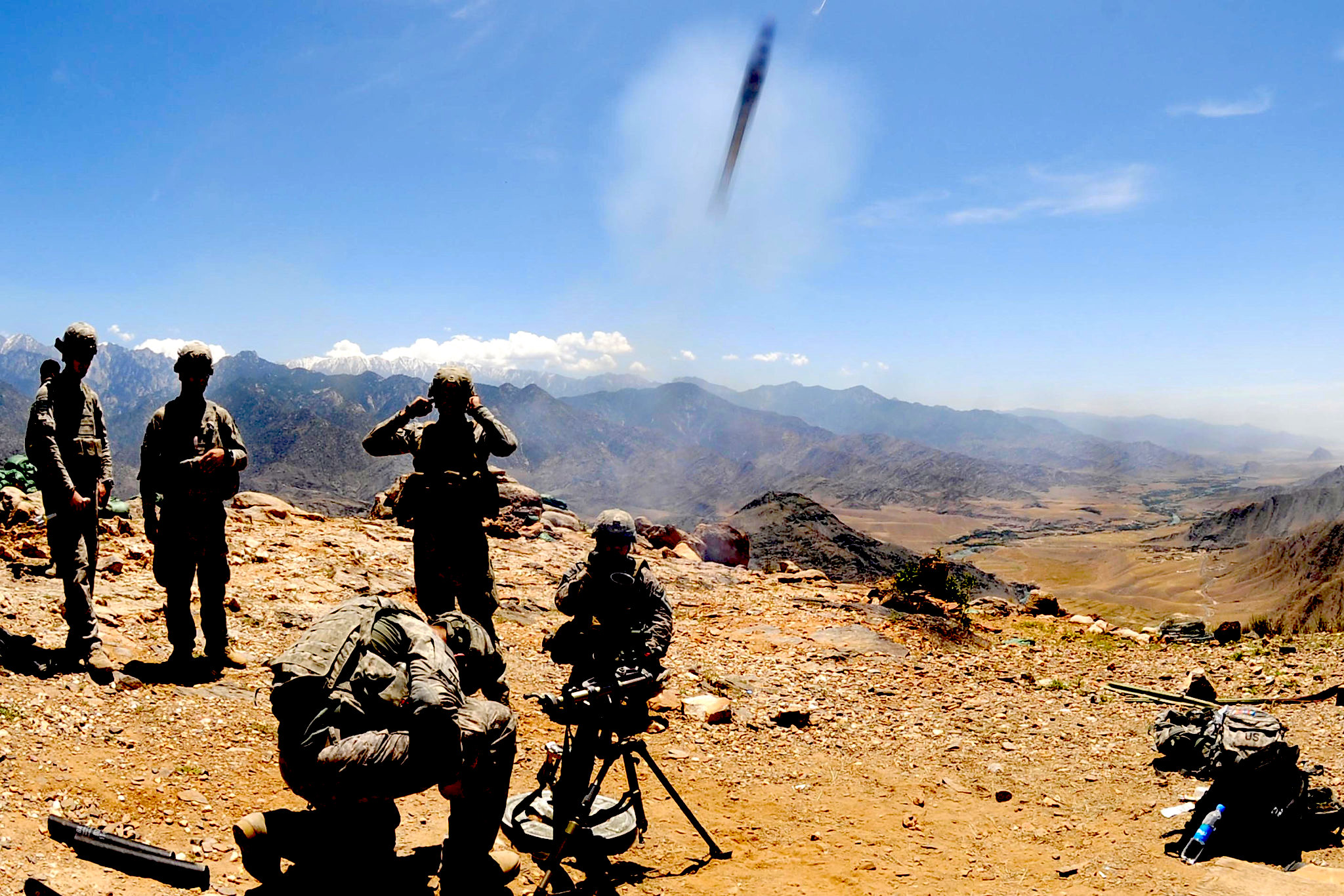When war is profit, death ensures a healthy bottom line, writes Christian Sorensen in this final installment of his five-part series on the military-industrial-congressional complex.
Read Part 1, Part 2, Part 3 and Part 4

U.S. Army soldiers training at Nangarech, Afghanistan, May 15, 2010. (U.S. Air Force, Steven Doty)
By Christian Sorensen
Special to Consortium News
 Without looking at military adventurism through the lens of the corporation, analysts are bound to produce error-filled studies. For example, one analyst contended in an interview on The Real News Network, “Military force is almost never going to achieve your political aims. The Americans learned this in Vietnam. They’re learning it in Afghanistan. They’re learning it in Syria… So [President Barack] Obama supporting the Saudis and Emiratis in Yemen is a sign really of incoherence on the part of the United States.”
Without looking at military adventurism through the lens of the corporation, analysts are bound to produce error-filled studies. For example, one analyst contended in an interview on The Real News Network, “Military force is almost never going to achieve your political aims. The Americans learned this in Vietnam. They’re learning it in Afghanistan. They’re learning it in Syria… So [President Barack] Obama supporting the Saudis and Emiratis in Yemen is a sign really of incoherence on the part of the United States.”
Far from incoherence, the behavior actually is quite rational. A variety of conflicts, disparate and some seemingly futile, is precisely the aim. Conflict itself — producing untold mountains of profit for war corporations and Wall Street — is the goal.
Recall that capital is money used to expand business in order to make more profit. Capital isn’t just building new factories to produce more goods from which to profit.
Capital is also putting money toward cultivating and promoting politicians who advocate for wars and broad military deployments; media and think tanks to propagandize and generate militant narratives; attaining through neoliberal economic policies a U.S. military establishment so rife with corporations that it becomes one bloated, self-sustaining, profitable entity; arranging industry pressure groups and think tanks to encourage and award high-ranking military officers who support and extend conflicts overseas; and marketing, pushing, and operating goods and services that harm populations and destabilize countries around the world, generating more profitable conflict.

Aug. 9, 2018: Back stage at the Pentagon as Vice President Mike Pence announced President Donald Trump’s vision of a Space Force. (DoD, Vernon Young Jr.)
The war industry pursues a portfolio of conflicts as any organized, dominant industry views the global marketplace, parses demographics, shapes consumer tastes, and pursues profit maximization at all costs. Afghanistan, Pakistan, Colombia, Iraq, Iran, Korea, Libya, Mexico, Palestine, the Philippines, Somalia, Syria, the Sahel, Ukraine, Yemen — each conflict has advantages and challenges, unique terrain and unique obstacles.
Industry’s products monitor, control and destroy populations. The particular goods and services selected are not the point here. The real rub is that from the eyes of the corporate suite, conflict must endure. Peace is not profitable. A strong portfolio of conflicts, which vary in intensity and scope, is what industry has achieved. Global capitalism demands infinite growth. War corporations’ portfolio approach demands endless, dispersed armed conflicts of varying intensity.
U.S. War Industry’s Foreign Sales

Sept. 4, 2018: Charles Hooper, director of the Defense Security Cooperation Agency, with reporters aboard a military aircraft en route to New Delhi (DoD, Lisa Ferdinando)
The U.S. war industry sells to capitalist regimes around the world through direct commercial sales and foreign military sales (FMS). FMS tend to deal with big-ticket items or goods and services of a sensitive nature. Through FMS, the U.S. government procures and transfers industry goods and services to allied governments and international organizations.
The Defense Security Cooperation Agency (DSCA) is the intermediary between the U.S. war industry and the FMS customer overseas. On any given day, DSCA is managing “14,000 open foreign military sales cases with 185 countries,” Lt. Gen. Charles Hooper explained at the Brookings Institution in 2019.
Violent and oppressive regimes are frequent customers, including London, Riyadh, Abu Dhabi and Tel Aviv. The Leahy Law, which is intended to prevent U.S. military assistance from reaching militaries that have committed serious human rights violations, is almost never enforced when it comes to FMS. The Arms Export Control Act requires recipients of U.S. war industry goods and services to use them only in self-defense.
So, customers of the U.S. war industry typically affirm that they’re using the goods and services in self-defense, and the U.S. government doesn’t press them on the matter. After all, there is a lot of cash at stake. In fiscal year 2020 alone, the war industry sold $50.8 billion through FMS and $124.3 billion through direct commercial sales.

May 20,2017: A flyover of military aircraft during the welcoming ceremony in Riyadh, Saudi Arabia, for President Donald Trump. (White House, Andrea Hanks)
The Pentagon often cites industry’s claim that FMS reduces the cost of military systems to the U.S. Armed Forces. The Pentagon supports FMS because foreign militaries dependent on U.S. equipment, knowhow, training, parts, and software are more likely to listen to the U.S. government on military matters, the direction to take in regional conflicts, and international policy.
Without tensions, military provocations, and ongoing hot or cold wars (e.g. Japan v. China, South v. North Korea, Taiwan v. China, absolutist Arab regimes and Apartheid Israel v. Iran, Apartheid Israel v. Arab populations, the global war on drugs) to justify endless transactions, the U.S. war industry would lose billions in annual sales to allied regimes and sales to the U.S. military that is “responding” to such conflict.
Major war corporations place people in charge of selling to each Arab country in the Persian Gulf (e.g. Joe Rank, a career soldier who helped guide Middle East policy for the U.S. Secretary of War, now oversees Lockheed Martin’s business with Saudi Arabia). U.S. flag officers who work on FMS often doff the uniform and then join war corporations to help sell goods and services overseas.
For Profit, Against Democracy
From May 2015 through March 2016, U.S. war corporations sold over $30 billion of goods and services to anti-democratic Arab Gulf allies. Given the U.S. war industry’s long sales history to regimes like Bahrain, Saudi Arabia and the UAE, it stands firmly on the side of profit, and firmly against democracy. Or, as Raytheon’s website puts it,
“With more than 50 years in the Middle East, Raytheon’s steadfast commitment and uninterrupted presence in the region is a testament to the tremendous value we place on being there for our customers.”

FDR: Making a deal with Saudis that still governs the nations’ relations.
The 1945 Quincy Pact between U.S. President Franklin D. Roosevelt and King Abdul Aziz al-Saud started it all: Washington would entrench bases in and around the Persian Gulf and protect the House of Saud, while the latter would keep the oil flowing and give preferential treatment to U.S. corporate interests.
The Saudi regime would later agree to use the dollar in international oil trading. Saudi Arabia purchases a lot of goods and services from U.S. industry, including the war industry. The Washington regime assented when in 2015 the Saudi and Emirati regimes turned U.S. weaponry on Yemen.
The U.S. war industry, in addition to U.S. military and intelligence assistance, has been the cornerstone of the UAE/Saudi destruction of Yemen. Yemenis now suffer from raging famine, disease outbreaks, and crippled infrastructure. The UAE-Saudi coalition has hit civilians (school field trips, funeral processions, weddings, markets) and prevented humanitarian aid from entering Yemen.

June 26, 2019: Child displaced by war at the Lamkmat al-Hajfar camp near the rural Yemeni town of Al-Dahle. (EU Civil Protection and Humanitarian Aid, Flickr, Peter Biro)
In autumn 2018, the head of the U.S. State Department’s legislative affairs team (a former Raytheon lobbyist) certified that Saudi Arabia and the UAE were taking steps to reduce civilian deaths in Yemen. Roughly 233,000 people have died in Yemen as a result of the war, according to the United Nations humanitarian office. Such destruction is evidence of the military-industrial-congressional triangle functioning as designed.
In early February 2021, the Biden administration announced it would halt support for Saudi-UAE “offensive” operations in Yemen. This claim is full of loopholes and is unlikely to substantially alter or end the myriad of ways the U.S. ruling class aids and abets anti-democratic Arab regimes.
Zionism is the ideology that justifies the colonization of Palestine and the maintenance and expansion of that colonization using brutal violence and espionage. Zionists declared independence when they set up a new state, Israel, in Palestine in May 1948, ethnically cleansing hundreds of thousands of Arabs from the land.
Each year, Washington gives roughly $3.8 billion to Israel, which then is supposed to use such monies to purchase from the U.S. war industry. The occupation of Palestine and Zionist aggression against neighboring countries provide the U.S. war industry with a valuable slice of its portfolio: an outsourced proving ground to test, evaluate, use, and improve weaponry.
When war is profit, death ensures a healthy bottom line.
The Advantages of Zionism
The aggressive military posture inherent to Zionism is a commercial advantage from an industry perspective. Israel has killed Arabs quite effectively with a variety of aircraft and weaponry purchased from U.S. corporations. The U.S. State Department turns a blind eye, as it is once again doing in the current Israeli operation. Of course, Israel claims self-defense when using U.S. and Israeli weaponry to kill Arabs.
The U.S. and Israeli war industries collaborate, including through research & development and joint ventures. In April 2019, the U.S. war industry pressure group NDIA signed an agreement with the Manufacturers Association of Israel, bringing the latter into the former’s International Division.
Executives of U.S. war corporations travel to Israel regularly. U.S. war corporations have offices there to oversee such collaboration, the U.S. tax dollars that flow through the apartheid state, and reciprocal procurement deals wherein major U.S. war corporations invest in and partner with Israeli corporations on large contracts. Heavy Israeli espionage and lobbying guarantee the Washington regime does not stray from this unconditional support of the apartheid state.
Great Power Competition
 Pretexts keep the military budget elevated, sustain the war industry’s profits, and incite a violent foreign policy. Manufactured fear is essential. After pumping the “War on Terror” for trillions of dollars — and with veterans and the U.S. public growing skeptical of such interventions — the war industry has returned to targeting Russia and China through “great power competition.”
Pretexts keep the military budget elevated, sustain the war industry’s profits, and incite a violent foreign policy. Manufactured fear is essential. After pumping the “War on Terror” for trillions of dollars — and with veterans and the U.S. public growing skeptical of such interventions — the war industry has returned to targeting Russia and China through “great power competition.”
Facing off against Russia and China is more comfortable territory for war corporations. In the calculus of corporate suites, the big-ticket items inherent to competition with another major industrial nation are where the real money can be made. A war on terror was lucrative for a decade or two, and it will continue, but it is not enough to justify excessive spending on cyber, submarines, satellites, hypersonic propulsion, anti-ballistic missiles, nuclear weaponry, artificial intelligence/machine learning, and aircraft carriers.
Competition against Moscow and Beijing also continues the militarization of U.S. society, channeling anger (which might otherwise manifest itself as class awareness and/or physical protest against Washington’s corruption) into outrage against a stereotypical enemy that resides overseas — just as the War on Terror did.
Great power competition is fully entrenched in the Pentagon, as made clear by the 2018 National Defense Strategy, developed in 2017 by military and corporate personnel. It emphasized, “inter-state strategic competition, not terrorism, is now the primary concern in U.S. national security.”
Etching the National Defense Strategy into stone, the then chairman of the Joint Chiefs of Staff, General Joseph Dunford declared in November 2018, that great power competition was here to stay, demanding a shift in Pentagon funding priorities and weapons development. Dunford was speaking at the Halifax International Security Forum, sponsored by corporations (e.g. Boeing, CAE, United Technologies) and NATO, among other powerful groups, including energy and IT firms.

Chairman of the Joint Chiefs of Staff, General Joseph Dunford, at right, meets with Israeli Prime Minister Benjamin Netanyahu in his office in Jerusalem, May 2017. (U.S. Embassy Tel Aviv)
Four months later, the war industry pressure group NDIA presented General Dunford with its most prestigious award. Dunford soon retired and joined the board of Lockheed Martin.
Great power competition has enabled a high volume of war industry goods and services and U.S. military personnel to deploy to Germany, the Czech Republic, Poland and eastern Europe, particularly in the Baltic States and Romania, as well as other clients surrounding China, particularly South Korea, Japan, Taiwan and Guam. Large engineering and project management firms build and sustain the associated infrastructure.
Meanwhile, Beijing’s construction is framed as a threat. “I mean, this is insane. Look at all that crazy construction,” remarked a U.S. naval officer observing Chinese military construction projects in the South China Sea. Though a useful bogeyman, Beijing’s construction in the South China Sea does not hold a candle to what Washington has built up overseas.
Great power competition fills peaceful voids. At the Sea Air Space Forum of 2019 (sponsored by CACI, Lockheed Martin, Northrop Grumman, and shipbuilder Huntington Ingalls), MIC officials cited the “threat” of great power competitors in order to justify expansion of U.S. military power into the Arctic.
They ignored the real threat: The U.S. Armed Forces’ rampant carbon-based military activity contributes to anthropogenic climate change, which melts Arctic ice, which opens up northern sea lanes, into which the Pentagon projects its polluting arsenal, which puts more carbon in the atmosphere.
Great power competition’s consequences are terrifying: increased militarization of an already militarized U.S. economy and public life; greater likelihood of wars big and small; more pollution (notably toxic particulates, carbon emissions, and radiological contamination) in an era of climate catastrophe and mass extinction; nuclear weapons on a hair trigger; narrowing of permissible speech and assembly; and relentless corporatization of the U.S. Armed Forces, the world’s mightiest organization.
The pretext known as great power competition is off to an impressive start, financially, bureaucratically, and industrially. It is incumbent upon the workers of the world to stop it.
This is the final installment in the author’s five-part series.
Christian Sorensen is an independent journalist mainly focused on war profiteering within the military-industrial complex. An Air Force veteran, he is the author of the recently published book, Understanding the War Industry. He is also a senior fellow at the Eisenhower Media Network (EMN), an organization of independent veteran military and national security experts. His work is available at War Industry Muster.
The views expressed are solely those of the author and may or may not reflect those of Consortium News.




A sad reflection on a lost world.
One true thing can be said about finding ourselves in the “pit”, at the bottom of our governments abilities. There is only one way to go from here.
Christian Sorensen I applaud you effort here and I want to apologize up front for any shade I might cast your way.
What you have written about here is something any American over 50 should already know. The problem is most are clueless by desire. The result of being to lazy or too poorly educated to partake in critical thought.
I often rail about the failure of the two party system because the two parties have become one in the same. The ruling elite of both parties are playing their own game and the rest of us aren’t in that game, unless of course on donate money to their favorite party.
It has come to the point that voting simply legitimizes a phony system. By the way where the hell is Karl “porky the pig” Rove. Seriously where do yo think he has been?
When it appeared that Trump might win things started to go south for Dems, see the Demo email disaster of the summer of 2016.
The Dems had tried every dirty trick in the book to get their guy Joe B at the top of their ticket and where successful. They had fallen for the trap, being that, ” hell Trump couldn’t win”. Counted on winning congress which was a pipe dream and well, check again suckers.
The second most powerful party in the US then put all their eggs in one basket, “we gotta beat Trump!”, the entire tire time screaming we gotta win the congress and failed to ensure that they did both. (the dark music starts here)
What happened, they failed to try to win congress. Fatal error. I am far from being any high powered political mind but after watching Repugs for all my life screw over everyone I was on guard. After the supreme court ruled in favor of money being speech I knew damned well where repugs were headed, if they got the white house and congress both and they did.
Trump got elected an immediately started appointing judges, no surprise after seeing how repugs acted toward Obama who is no hero of mine BTW, and who also suffered from the democrats not backing 100%. It was then that the repugs smelled blood. They knew instinctly what it meant when the dimos didn’t go lock step with the young black president.
Then Biden got elected and now is powerless to do anything to significantly change the course of the ship of state. No surprise here either for me. ( no power in the courts or congress )
And surprise, surprise what are rupugs doing, what ever they please. Any attempt by dimos to punish Trump and the repugs has to go through courts where Trump appointed judges, just as I figured he would. It is the repug “MO”.
Biden got his presidency and anyone believing in the current two party system got exactly what they deserved.
I figure Biden could be no worse than Trump, my mistake. Biden and the dims are or will be responsible for wasting the next four years only to find themselves out of the white and Congress the next election cycle. The dimos elected an eighty year old DC relic when two forty year olds couldn’t do the job he took with out either the courts or congress. You have to have at least one of the two.
They will get nothing done. The dimos play patsy and make billions doing so.
Black Roses and Sad Music starts here.
All this and the media which is supposed to have the inside info on the goings on sits back and wrings the hands saying “Can you believe what the repugs are dong it’s so, it’s so , wrong.” Yes, you dumb asses I can believe it.
I knew they would win at all cost and take no prisoners and that is what they are doing.
Mr. Sorenson you article cannot overcome the uninterested uneducated voter, it seems they have gotten what they sowed. You want to talk about an uphill slog, well you youngsters are in for one. My apologies again, this time for the mess my generation left you folks.
Now where did I put my Kevlar undies.
Thanks CN
I’m not sure it was mentioned in any of the articles but the educational and other benefits extended to volunteers after they leave the military make the choice of young people to join almost impossible to ignore. Patriotism, to defend your country, is likely down the list for our new volunteers. What kind of military that creates makes you wonder how effective such recruits would be if fighting starting.
Sorenson’s knowledge of MIC is extraordinary and appreciated. I hope it does some good.
Thank you Mr Sorensen for your excellent series of articles. It’s becoming common knowledge that the US war industry steals from working Americans via monopolizing the majority of their tax dollars that would otherwise be available to meet human needs, but you do a great service in revealing the war industry’s vital role in surplus value extraction under capitalism. Not content to merely feast on tax dollars the MIC drains value from the working lives of hundreds of thousands of people in the US, while propping up this system of organised vampirism worldwide.
I’m sure CN readers would love to hear your take on the relationship between the US war industry and capitalism on a global scale. What does Western imperialism look like as an economic system and how does US military power underpin it? (The “McDonnell Douglas behind the McDonald’s” as Tom Friedman so crassly put it). 2021 is the 105th anniversary of V.I. Lenin’s pamphlet ‘Imperialism: The Highest Stage of Capitalism. Much has changed in 105 years but at its core capitalism has not.
An excellent finale to the series, especially coming on the heals of the recent Lauria and Johnstone articles. To Mr. Sorensen, thank you for your service to journalism.
Thank you for your hard work on this. I intend to promote your book with an article in my magazine, and would appreciate a chance to ask you some questions.
I second. Thank you Christian Sorensen for a most informative, wellwritten 5-part series.